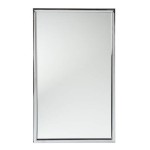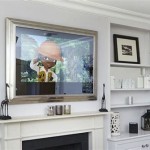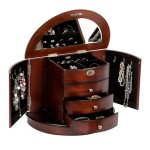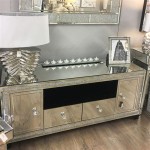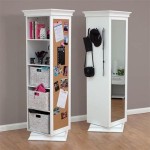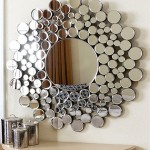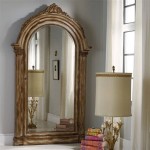Framing Mirrors: Aesthetic Enhancement and Interior Design Integration
Framing mirrors is a multifaceted approach to enhancing both the aesthetic appeal and functional integration of mirrors within interior spaces. Beyond simple reflection, a well-chosen frame can transform a mirror into a focal point, complementing the existing design scheme and contributing to the overall ambiance of a room. The selection of a suitable frame involves careful consideration of various factors, including the mirror's size, shape, and intended location, as well as the prevailing design style of the space.
The material used for the frame plays a significant role in determining its visual impact and durability. Common materials include wood, metal, and synthetic polymers, each offering a distinct set of advantages and disadvantages. Wood frames, for instance, can provide warmth and texture, lending a natural and organic feel to the mirror. Metal frames, on the other hand, often impart a sleek and modern aesthetic. Synthetic polymers offer versatility in terms of design and color options, and can be more resistant to moisture and damage than natural materials.
The style of the frame is equally important, ranging from ornate and traditional designs to minimalist and contemporary options. Ornate frames often feature intricate carvings, embellishments, and gilded finishes, adding a touch of luxury and sophistication. Minimalist frames typically prioritize clean lines, simple shapes, and understated finishes, creating a sense of elegance and restraint. The choice of frame style should align with the overall design aesthetic of the room, ensuring a cohesive and harmonious visual experience.
Material Considerations for Mirror Frames
The choice of material for a mirror frame significantly influences its aesthetic qualities, durability, and suitability for specific environments. Wood, metal, and synthetic polymers represent the most commonly employed materials, each possessing unique characteristics. The selection process should carefully evaluate the intended application and desired aesthetic outcome.
Wood frames offer a classic and versatile option, available in a wide range of species and finishes. Hardwoods such as oak, maple, and cherry provide exceptional durability and resistance to wear, making them suitable for high-traffic areas. Softwoods like pine and cedar are more affordable and can be easily stained or painted to match existing décor. Wood frames can be intricately carved or molded to create elaborate designs, adding a touch of elegance and sophistication to the mirror. However, wood is susceptible to moisture damage and may require special treatments to prevent warping or rot in humid environments.
Metal frames provide a sleek and modern alternative, often constructed from materials such as aluminum, steel, or brass. Aluminum frames are lightweight, corrosion-resistant, and available in a variety of finishes, including brushed, polished, and powder-coated. Steel frames offer superior strength and durability, making them ideal for heavy or oversized mirrors. Brass frames exude a sense of luxury and sophistication, but may require regular polishing to maintain their shine. Metal frames are less susceptible to moisture damage than wood frames, but can be prone to scratches and dents. Metal frames provide a clean and contemporary aesthetic, making them a good choice for modern designs.
Synthetic polymer frames, including materials like polystyrene and PVC, offer a cost-effective and versatile option. These materials are lightweight, moisture-resistant, and available in a wide range of colors and textures. Synthetic frames can be molded into intricate shapes and designs, mimicking the appearance of wood or metal. They are also resistant to cracking, warping, and fading, making them suitable for use in bathrooms and other humid environments. While synthetic frames may not possess the same level of aesthetic appeal as wood or metal frames, they offer a practical and durable solution for framing mirrors in a variety of settings.
Style and Design Integration of Mirror Frames
Mirror frame style and design should harmonize with the existing interior design to create a cohesive and aesthetically pleasing environment. Several design styles can be considered, ranging from traditional to contemporary and minimalist, each requiring a different approach to framing. The selection of frame style has significant bearing on the overall impression the mirror conveys.
Traditional mirror frames often feature ornate details, such as intricate carvings, gilded finishes, and decorative moldings. These frames are typically made from wood and are designed to evoke a sense of elegance and grandeur. Traditional frames often complement antique furniture, ornate lighting fixtures, and rich color palettes. They are particularly well-suited for formal living rooms, dining rooms, and bedrooms. The use of gilding and complex carvings contributes to the overall feeling of luxury and opulence.
Contemporary mirror frames are characterized by clean lines, simple shapes, and understated finishes. These frames are often made from metal or synthetic materials and are designed to complement modern furniture, geometric patterns, and neutral color palettes. Contemporary frames are well-suited for minimalist interiors, lofts, and urban apartments. They are known for their practicality and efficient design. The focus is on functionality and visual lightness.
Rustic mirror frames embrace natural materials, such as reclaimed wood, distressed metal, and unfinished surfaces. These frames often feature imperfections and irregularities, adding a touch of character and authenticity. Rustic frames are well-suited for farmhouse-style interiors, cabins, and country homes. They create a warm and inviting atmosphere, enhancing the natural beauty of the surrounding environment. The use of natural textures and materials contributes to a sense of tranquility and connection to nature. The handcrafted appearance of rustic frames adds to their charm.
Minimalist mirror frames prioritize simplicity and functionality. These frames are typically frameless or feature thin, unobtrusive edges. They are designed to blend seamlessly into the background, allowing the mirror to take center stage. Minimalist frames are well-suited for small spaces, modern interiors, and areas where a clean and uncluttered look is desired. They create a sense of spaciousness and airiness, enhancing the overall feeling of calm and tranquility. The absence of ornamentation emphasizes the functionality and reflective properties of the mirror. The minimalist approach is highly popular in modern design, emphasizing functionality and simplicity.
Practical Considerations for Mirror Frame Selection
Beyond aesthetic considerations, practical factors also play a critical role in the selection of mirror frames. These include the size and shape of the mirror, its intended location, and the functional requirements of the space. Addressing these considerations ensures that the framed mirror is not only visually appealing but also practical and durable.
The size and shape of the mirror directly influence the choice of frame. Large mirrors may require heavier and more robust frames to provide adequate support and prevent warping. Smaller mirrors can accommodate lighter and more delicate frames. The shape of the mirror should also be taken into account when selecting a frame. Rectangular mirrors typically pair well with simple, geometric frames, while round mirrors may benefit from curved or ornate frames. The frame shape should complement the mirror's curvature to create a visually harmonious whole.
The intended location of the mirror is a crucial factor in determining the appropriate frame material and finish. Mirrors placed in bathrooms or other humid environments require frames that are resistant to moisture damage. Synthetic polymer frames or metal frames with a protective coating are often the most suitable options. Mirrors placed in high-traffic areas may require frames that are resistant to scratches and dents. Hardwood frames or metal frames are generally more durable than softwood frames. The frame's finish should also be appropriate for the location. For example, a matte finish may be preferable in a brightly lit room to reduce glare, while a glossy finish may be more suitable for a dimly lit room to enhance reflection and brighten the space.
The functional requirements of the space should also be considered when selecting a mirror frame. Mirrors used for grooming or applying makeup may benefit from frames with integrated lighting or storage. Mirrors used in entryways or hallways may require frames that are durable and resistant to impact. The frame's design should also complement the overall functionality of the space. For example, a minimalist frame may be preferable in a small space to avoid cluttering the visual field, while an ornate frame may be more suitable for a large space to add a touch of grandeur. The mirror should be carefully positioned and securely mounted to ensure proper functionality and safety.
Ultimately, framing mirrors is an art form that blends aesthetic sensibilities with practical considerations. By carefully selecting materials, styles, and designs, it is possible to transform a simple mirror into a statement piece that enhances the beauty and functionality of any interior space. The process requires careful attention to detail and a comprehensive understanding of the principles of interior design.

How To Frame A Mirror

Mirror Frame Diy How To Update A Basic Bathroom Our Faux Farmhouse
:max_bytes(150000):strip_icc()/bloomingdiyer-372b1cae2a6c43af917f3bea506c11da.jpg?strip=all)
20 Diy Mirror Frame Ideas To Inspire Your Next Project

How To Frame Out That Builder Basic Bathroom Mirror For 20 Or Less Design Mirrors Diy Elegant

Diy Stick On Mirror Frame Sawdust Sisters

30 Diy Mirror Frames Scratch And Stitch

20 Easy Creative Diy Mirror Frame Ideas
:max_bytes(150000):strip_icc()/alahome1-a879d69e31be4a9a9ae522028c12926d.jpg?strip=all)
20 Diy Mirror Frame Ideas To Inspire Your Next Project

20 Creative Diy Mirror Frame Ideas To Inspire Your Next Project Bathroom Mirrors Makeover

10 Diy Ideas For How To Frame That Basic Bathroom Mirror
